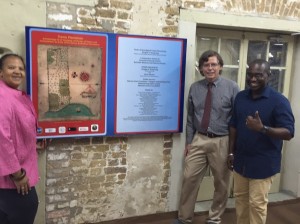Engaged Anthropology Grant: Douglas V. Armstrong

Douglas V. Armstrong is a Professor of Anthropology at the Maxwell School of Citizenship and Public Affairs at Syracuse University. In 2012 he received a Post-Ph.D. Research Grant to aid research on “Archaeological Investigation of Early Transformations on Barbadian Plantations”. In 2014 Dr. Armstrong received an Engaged Anthropology Grant to aid engaged activities on “Archaeology of the Shift to Sugar and Slavery in Barbados: Public Interpretation”.
As a follow-up to Wenner-Gren funded research on early-17th century plantations in Barbados I was asked by the Barbados Museum to organize an exhibit and public presentation of findings. A Wenner-Gren Engaged Anthropology Grant provided me with the resources necessary to organize an exhibit and related events aimed at conveying information on the research to the people of Barbados and engaging with the public. An exhibit titled “Landscaped of Power, Enslavement, and Resistance: Archaeology of the Early 17th Century Settlement at Trents Plantation, Barbados.” This exhibit was organized and installed at the Barbados Museum in March 2016 with the assistance of Keven Farmer, Deputy Director of the museum. This exhibit was part of Barbados commemoration of its 50th Anniversary of independence (Figures 1-3)

The exhibit presented panels and artifact display cases projecting information recovered from three themes of archaeological research at Trents Plantation. The text, photographs, and artifacts conveyed information on archaeological and historical research exploring the shift from a small-scale farming settlement (1620s-1640s) to a large scale sugar plantation (post 1640s). This part of the exhibit described the historical research and archaeological studies that resulted in the identification of a pre-sugar settlement at Trents and explored the cultural landscape of the pre-sugar era. It used findings from the site to illustrate the small-scale nature of pre-sugar settlement as well as archaeological and historical data which combined to show how plantation farmers and laborers (including indentured Europeans and enslaved Africans) lived in close quarters during the pre-sugar era. Visitors continued through the exhibit to review comparative data from contexts associated with the planter’s residence to data from the enslaved laborer settlement at the plantation (1640s-1838) and described the abandonment of that settlement at the time of emancipation. The survival of an unplowed enslaved laborer settlement at Trents provides a unique opportunity to examine life and living conditions on a Barbadian plantation. Finally, the exhibit presented an unveiling of artifacts from a newly discovered cave site on the property, Trents cave. Evidence from Trents cave, or the “cave of iron and steel”, provides a glimpse at a hidden place of African-Barbadian social interaction, ritual practice, and resistance.

Preliminary work for the exhibit began in the summer of 2015 when I worked with Keven Farmer to frame the scale and scope of the field work that was then just being completed. Throughout the project the public was invited to visit the site to participate in the project and to learn about our findings. In advance of the exhibit two articles on the project were published in the Journal of the Barbados Museum and Historical Society, and a third in the proceedings of the International Congress of Caribbean Archaeology.
Armstrong, Douglas V., 2015. Cave of Iron and Resistance: A Preliminary Examination. Journal of the Barbados Historical Society. 61: 178-199.
Armstrong, Douglas V., 2015. Archaeology of the Enslaved Laborer Settlement at Trents Plantation: 2014-2015. Journal of the Barbados Historical Society. 61: 146-177.
Armstrong, Douglas V., 2015. Archaeology at Trents Plantation, Barbados. Actas del 25to Congreso International de Arqueología del Caribe. Instituto de Cultura Puertorriqueño, el Centro de Estudios Avanzados de Puerto Rico y el Caribe y la Universitad de Puerto Rico, Recinto de Río Piedras. Pp. 1030-1048.
During the summer of 2015 I began to organize the exhibit and I corresponded with Keven Farmer to define dates and to set up the timing of a public lecture. Initially, the exhibit was set to open in May of 2016. However, it was decided to integrate the exhibit into the opening of Barbados’ 50th Anniversary Celebration and to also organize a second exhibit examining Barbados’ slave revolt of 1816. In January 2016 I spent a week in Barbados organizing the Trents – “Landscapes of Power, Enslavement, and Resistance” exhibit and also assisting with the “Freedom: We Must Fight For It” exhibit. In March of 2016 I returned to Barbados to work on the installation and on June 24, I presented a public lecture at the museum describing the research and explaining the exhibit.
The exhibit was well received and resulted in interest from organizers of the Smithsonian’s African American History Museum, who visited the exhibit. This has resulted in support for the installation of a permanent exhibit and a joint effort funded by the Smithsonian aimed at capacity building in the area of archaeology, digital databases, curation, public engagement. This project will be coordinated by Kevin Farmer (Barbados Museum) and I will coordinate instruction relating to archaeology during summer courses for Barbadian and Caribbean students over the next three years.